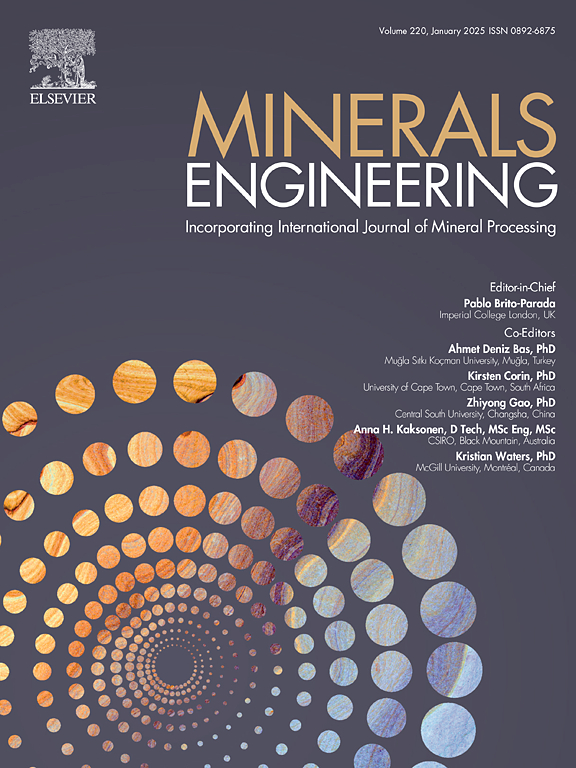通过酸碱水热合成高岭土层状硅酸盐衍生的二氧化硅量子点用于抗癌
IF 4.9
2区 工程技术
Q1 ENGINEERING, CHEMICAL
引用次数: 0
摘要
本研究提出了一种绿色可持续的方法,以印度尼西亚西爪哇Cipatujah的高岭土为原料,采用两步水热酸碱法合成二氧化硅量子点(QDs)。高岭土是一种天然丰富且低成本的层状硅酸盐矿物,主要由Al2Si2O5(OH)4组成,用作二氧化硅前驱体。第一步,用盐酸对高岭土进行水热处理,去除铁、锰等杂质,提取正硅酸。第二步,在相同的水热条件下,用氢氧化钠(NaOH)处理纯化后的材料,诱导键断裂,并通过硅酸盐中间体促进纳米级二氧化硅的形成。该方法成功地制备了高纯度的二氧化硅量子点。x射线荧光(XRF)分析证实二氧化硅(SiO2)含量为90.2%。高分辨率透射电子显微镜(HRTEM)和场发射扫描电子显微镜(FESEM)显示球形和非晶态颗粒。细胞毒性试验显示,对B16F0黑色素瘤和MCF-7乳腺癌细胞有明显的剂量依赖性抑制作用,孵养24 h时的半数最大抑制浓度(IC50)值分别为134 ppm和147 ppm。这种环境友好的合成策略在利用天然矿物资源的同时最大限度地减少了危险试剂的使用,与可持续纳米技术的原则保持一致。这一发现强调了高岭土衍生二氧化硅量子点作为生物相容性和生态友好型纳米材料用于癌症治疗的潜力。本文章由计算机程序翻译,如有差异,请以英文原文为准。

Kaolin phyllosilicate-derived silica quantum dots via acid-base hydrothermal synthesis for anti-cancer applications
This study presents a green and sustainable approach for synthesizing silica quantum dots (QDs) from kaolin phyllosilicate collected in Cipatujah, West Java, Indonesia, via a two-step hydrothermal acid–base method. Kaolin, a naturally abundant and low-cost phyllosilicate mineral composed primarily of Al2Si2O5(OH)4, served as the silica precursor. In the first step, kaolin was hydrothermally treated with hydrochloric acid (HCl) to remove impurities such as Fe and Mn and to extract orthosilicic acid. In the second step, the purified material was treated with sodium hydroxide (NaOH) under identical hydrothermal conditions, inducing bond scission and promoting the formation of nanoscale silica via silicate intermediates. This method successfully yielded high-purity silica QDs. X-ray fluorescence (XRF) analysis confirmed a Silica (SiO2) content of 90.2 %. High-resolution transmission electron microscopy (HRTEM) and field-emission scanning electron microscopy (FESEM) revealed spherical and amorphous particles. Cytotoxicity assay demonstrated significant dose-dependent inhibitory effects on B16F0 melanoma and MCF-7 breast cancer cells, with half-maximal inhibitory concentration (IC50) values during 24 h incubation of 134 ppm and 147 ppm, respectively. This environmentally friendly synthesis strategy minimizes the use of hazardous reagents while utilizing natural mineral resources, aligning with the principles of sustainable nanotechnology. The findings underscore the potential of kaolin-derived silica QDs as biocompatible and eco-friendly nanomaterials for cancer therapy.
求助全文
通过发布文献求助,成功后即可免费获取论文全文。
去求助
来源期刊

Minerals Engineering
工程技术-工程:化工
CiteScore
8.70
自引率
18.80%
发文量
519
审稿时长
81 days
期刊介绍:
The purpose of the journal is to provide for the rapid publication of topical papers featuring the latest developments in the allied fields of mineral processing and extractive metallurgy. Its wide ranging coverage of research and practical (operating) topics includes physical separation methods, such as comminution, flotation concentration and dewatering, chemical methods such as bio-, hydro-, and electro-metallurgy, analytical techniques, process control, simulation and instrumentation, and mineralogical aspects of processing. Environmental issues, particularly those pertaining to sustainable development, will also be strongly covered.
 求助内容:
求助内容: 应助结果提醒方式:
应助结果提醒方式:


